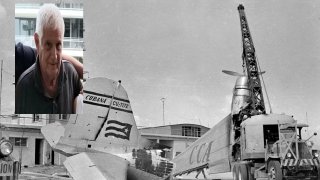
Sixty years before Juan Mora’s Surfside condo building came crashing down, killing him and at least 89 others, he was among hundreds of Cuban exiles who signed up for a covert, CIA-funded operation to overthrow Fidel Castro’s Soviet-backed dictatorship.
Mora’s dream of restoring democracy in his homeland took him from military training at a Guatemalan jungle camp to the failed 1961 Bay of Pigs invasion, where he was captured and then crammed into a decrepit, rat-filled Cuban prison for 20 months, friends once imprisoned with him told The Associated Press.
Watch NBC6 free wherever you are
Authorities on Wednesday identified the remains of 80-year-old Juan A. Mora, also known as Juanito, recovered from therubble of the Champlain Towers South building in Surfside. Others killed included his wife, Ana, and their adult son, Juan Mora Jr., who worked in Chicago and had been staying with his parents when their 12-story building suddenly pancaked on June 24.
Mora Sr. was a much-liked figure in the Miami area Cuban-American community, once active in the Bay of Pigs Veterans Association and the Bay of Pigs Museum it houses, museum board member Humberto Lopez said Friday. Mora was “always trying to help,” organizing events, writing editorials about the invasion and emailing with other members of the veterans group, Lopez recalled.
Get local news you need to know to start your day with NBC 6's News Headlines newsletter.
Lopez said he and the loquacious Mora were close for the past decade, and described his wife as “charismatic.”
Ana Mora had worked as assistant to the president of a prestigious Catholic high school in Miami, Belen Jesuit Prep, from which the couple’s son had graduated, said another family friend, Johnny Lopez de la Cruz, president of the museum and veteran’s association.
Mora Jr. was a manager for Morton Salt’s road salt business in Chicago, according to a close friend there, Matthew Kaade, who graduated with him from Loyola University in Chicago in 2011.
Local
Lopez de la Cruz said Mora Sr. also had two daughters from a prior marriage. Another friend, Humberto Diaz Arguelles, said Mora’s first wife died of cancer.
Mora Sr. was part of a band of Cuban exiles funded by the CIA late in the Eisenhower administration to help counter Soviet influence and missiles placed in Cuba. The volunteers were sent to training camps in Guatemala’s jungle in 1960 and early 1961. The force came to be known as Brigade 2506 — the ID number of the first casualty, a man who fell off a cliff during a training accident, said Diaz Arguelles, who trained at one of the camps with Mora.
They lived in tents, eating food that was sometimes spoiled and drinking river water as they learned to use machine guns, grenades, bazookas and mortars.
“We were so convinced about what we were doing to go free Cuba that nobody complained,” Diaz Arguelles remembered.
He said Mora, a radio operator in the brigade's Battalion 3, was lively and popular and “always talking about every subject you can think of.”
When training ended in April 1961 and the fighters headed to Cuba, they realized they weren’t getting the help they’d been promised by the U.S. military, including aerial support and a “navy armada,” Diaz Arguelles said. Roughly 1,400 men were transported from a Nicaraguan port in rusty merchant cargo ships to the Bay of Pigs on Cuba’s southern coast, then had to climb down ropes in the dark to board “18-foot aluminum boats from Sears” and reach the beach — while under fire, because Castro had learned of the invasion in advance.
“There was no time to get scared,” said Diaz Arguelles, whose boat sank after hitting a reef, forcing him to swim ashore with a mortar tube and two boxes of ammo.
President John F. Kennedy, who authorized the mission barely three months into his term, had canceled a second planned airstrike after U.S. support for the April 17, 1961, invasion became known, according to the JFK Library.
After three days fighting the overwhelming Cuban force, hiding in swamps and running out of ammunition, water and food, more than 100 members of the 2506 Brigade had been killed. Diaz Arguelles and about 20 invaders were surrounded by Cuban troops and taken to Castillo del Principe, or Castle of the Prince, a huge military fort in Havana. There Diaz Arguelles again met Mora, who like him had been captured.
Diaz Arguelles said the prison was deteriorated and full of fungus, and they had to sleep on the floor with rats running over them at night. Their meager food had rats and cockroaches in it, and contaminated water left the men sick and weak.
Lopez also was imprisoned there and spent about eight months in the same cell with Mora, who was then moved elsewhere in the prison.
Nearly 1,200 prisoners eventually were returned to the U.S. in exchange for $53 million in food and medicine, according to the JFK Library. The Brigade 2506 survivors were flown to Florida just before Christmas 1962 and reunited with whatever family they had there.
Diaz Arguelles said he and Mora both got jobs and worked their way through college.
The men had drifted apart for years but reconnected after retirement. Diaz Arguelles recalled Mora had owned a business selling hurricane-proof windows and doors for at least a decade, and said they last spoke a couple months ago, naturally about the Bay of Pigs veterans group.
___
Follow Linda A. Johnson on Twitter: LindaJ_onPharma



